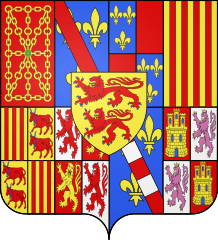
Henry IV of France
Henry IV (French: Henri IV; 13 December 1553 – 14 May 1610), also known by the epithets Good King Henry or Henry the Great, was King of Navarre (as Henry III) from 1572 and King of France from 1589 to 1610. He was the first monarch of France from the House of Bourbon, a cadet branch of the Capetian dynasty. He pragmatically balanced the interests of the Catholic and Protestant parties in France as well as among the European states. He was assassinated in 1610 by a Catholic zealot, and was succeeded by his son Louis XIII.
For other uses, see Henry IV (disambiguation).Henry IV
2 August 1589 – 14 May 1610
27 February 1594
Chartres Cathedral
9 June 1572 – 14 May 1610
13 December 1553
Château de Pau, Béarn
14 May 1610 (aged 56)
Palais du Louvre, Paris, France
1 July 1610
Calvinism (1553–1593)
Catholicism (1593–1610)
Henry was baptised a Catholic but raised in the Protestant faith by his mother. He inherited the throne of Navarre in 1572 on his mother's death. As a Huguenot (Protestant), Henry was involved in the French Wars of Religion, barely escaping assassination in the St. Bartholomew's Day massacre. He later led Protestant forces against the French royal army. Henry inherited the throne of France in 1589 upon the death of Henry III. Henry IV initially kept the Protestant faith (the only French king to do so) and had to fight against the Catholic League, which refused to accept a Protestant monarch. After four years of military stalemate, Henry converted to Catholicism, reportedly saying, "Paris is well worth a mass." As a pragmatic politician he promulgated the Edict of Nantes (1598), which guaranteed religious liberties to Protestants, thereby effectively ending the French Wars of Religion.
An active ruler, Henry worked to regularise state finance, promote agriculture, eliminate corruption and encourage education. He began the first successful French colonization of the Americas. He promoted trade and industry, and prioritized the construction of roads, bridges, and canals to facilitate communication within France and strengthen the country's cohesion. These efforts stimulated economic growth and improved living standards.
While the Edict of Nantes brought religious peace to France, some hardline Catholics and Huguenots remained dissatisfied, leading to occasional outbreaks of violence and conspiracies. Henry IV also faced resistance from certain noble factions who opposed his centralization policies, leading to political instability.
His main foreign policy success was the Peace of Vervins in 1598, which made peace in the long-running conflict with Spain. He formed a strategic alliance with England. He also forged alliances with Protestant states, such as the Dutch Republic and several German states, to counter the Catholic powers. His policies contributed to the stability and prominence of France in European affairs.
Though generally well-liked, Henry was considered a heretical usurper by some Catholics and a traitor to their faith by some Protestants.[43] Henry was the target of at least 12 assassination attempts, including by Pierre Barrière in August 1593[44] and by Jean Châtel in December 1594.[45]
Henry was killed in Paris on 14 May 1610 by François Ravaillac, a Catholic zealot who stabbed him while his coach was stopped on Rue de la Ferronnerie. The carriage was stopped by traffic congestion associated with the Queen's coronation ceremony, as depicted in the engraving by Gaspar Bouttats.[46][47] Hercule de Rohan, riding in the coach with the king, was wounded in the attack but survived. Ravaillac was immediately seized, and executed days later. Henry was buried at the Saint Denis Basilica.
His widow, Marie de' Medici, served as regent for their nine-year-old son, Louis XIII, until 1617.[48]
The arms of Henry IV changed throughout his lifetime:








